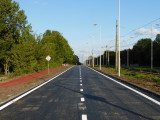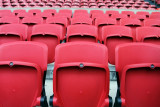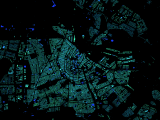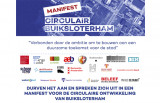Stay in the know on all smart updates of your favorite topics.
Road as materials depot

increasing recycled materials in asphalts
3D printing with local residual products (plastic waste)

Extra information
The Amsterdam ArenA (one of the most sustainable stadiums in the world) replaces in the run-up to the Euro 2020 all stadium seats and would like to do so in a socially responsible way.
It involves approximately 48,000 hard plastic chairs on metal frames and 4 to 5,000 more luxurious upholstered chairs of corporate boxes and grandstands. Along with Better Future Factory, an innovation and design firm specializing in recycling of plastic waste flows, the HvA will examine with the ArenA in what way the seats can be reused preserving the highest value as possible.
Amsterdam ArenA and HvA will explore one of the scenarios in collaboration with 3D4Makers, a company that works with (recycled) plastic filament for printers using Fused Deposition Modelling. The question is how the material of the stadium seats behaves with these processing techniques considering the impurity of the material.
In addition, this project investigates the technical and aesthetic properties of the processed material in order to determine what can be made for this type of products.
PUMA: Prospecting the Urban Mines of Amsterdam

exploring Amsterdam's 'urban mine'
Conclusion & results
Overall, most assumption were found to remain valid, although the validity of some assumptions could not be indicated, specifically due to the lack of access to roof spaces. However, five assumptions were found to be in need of revision, these are briefly listed in this chapter together with associated revision recommendations.
1. Buildings before 1900 were found to not include steel in the load-bearing
structure
Construction year data from the BAG register is available, which could provide
an indication of the metal content of the load bearing structure. Inclusion of the
construction year in the dataset, combined with a with a lower steel score for
buildings built before 1900, should be considered.
2. Apartments smaller than 75m2 were found not to have a separate toilet and
bathroom, instead the toilet was present in the bathroom
The assumed amenities of the 55 - 75m2 standard apartment could be changed to
one kitchen and a bathroom with toilet. The impact on the metal content should
be researched and adapted when change is found to be significant.
3. Recently completed buildings were found not to be included in the database
It should be ensured that the database is kept up to date in order to account for
these recently completed building.
4. Some buildings with a non-residential function were found to (temporarily)
accommodate a residential function
To account for all residential buildings, a clear distinction needs to be made
between the residential function and use of the building. Although the currently
used BAG function distinction might very well be adequate, research on the
relevance of including buildings used for residential purposes, but with other
functions according to the BAG register is recommended. This research should
account for the metal concentration in these buildings versus the amount of
these buildings in Amsterdam.
5. Some buildings were found to use electric cooking appliances rather than gas
The absence of gas connections in the kitchen is likely to lower the copper content
of the building. Because policy objectives increasingly aim to disconnect from
the gas infrastructure (ECN, 2016), it is recommended to research its impact on
the amount of copper in buildings to be able to accurately estimate the copper
content in the future.
Download the publication.
Go to the projectsite.
Partners:
Leiden University, Institute of Environmental Sciences: Ester van der Voet, Ruben Huele
Waag Society: Job Spierings, Ruben Huele
AMS Institute / Delft University of Technology, Faculty of Architecture and the Built Environment: Ellen van Bueren, Alexander Koutamanis, Boukje van Reijn
Metabolic: Anna Krotova
Industrial Ecology students: Luuk Gremmen, Sho Lin
Project leader / contact:
Ruben Huele, <a>urbmines@xs4all.nl</a>
AMS institute: Circular City research programme

To establish healthy and regenerative resource flows that retain or increase value in cities’ subsystems, there is dire need for new concepts as well as rigorous and critical testing of existing ones: both at an academic and practical level.
Introduction
To establish healthy and regenerative resource flows that retain or increase value in cities’ subsystems, there is dire need for new concepts as well as rigorous and critical testing of existing ones: both at an academic and practical level. This relates to e.g. aligning & connecting flows, exploring shared value models, implementing smart sensing technologies, identifying displacement effects etc. The impact on how cities are conceived, materialized and operationalized in a circular framework can hardly be overstated. Some impacts can be imagined, based on current knowledge, but most can at best be anticipated. This is due to cities being complex, adaptive systems. This notion resonates in the AMS institute Circular City research program through the three subthemes: materials & buildings, nutrients recovery from wastewater, and urban energy systems.
Each subtheme has its own research priorities, determined by the interplay between city, society and science. Furthermore, the three themes comprise multiple interrelations and synergetic potential. Think for example of the role that wastewater can play in thermal energy supply or the circulation of building blocks for plastics and other materials. Or how local nutrient recovery systems inform building design and neighbourhood development. Other examples are e.g. ‘embodied’ water and material use required for the energy transition we are facing, and rebound effects that may occur when such an energy transition leads to lower energy bills.
Subtheme 1: materials & buildings
Resource depletion and waste generation are two phenomena that, due to their nonregenerative and polluting character, hinder healthy and sustainable development of urban environments. A shift from linear to circular resource management offers a potential solution, but requires new production and consumption models. Not least with regard to buildings and infrastructures. The main focus of this theme is on materials that are temporarily stored in built constructions for diverging – medium/long – periods of
time, but also short cycle materials, such as solid waste flows, are part of the scope.
Three scale levels are distinguished with regard to aligning flows & stocks: building,
neighbourhood, and region. The value cases associated with this theme revolve around: enhanced data-driven urban systems thinking that enable effective regenerative material flows, adding value to public or private organizations and society at large. Breakthrough innovations are linked to evidence based analytical and forecasting tools to determine optimal material (re-) circulation on the one hand, and matching value-bydesign with new business models on the other.
AMS projects e.g.: PUMA, Adaptive Circular Cities, REPAiR
Subtheme 2: nutrients recovery
Decentralised sanitation systems can play an important role in circular cities, with regard to resilient and cost effective wastewater treatment systems, while valorising the wastewater flow through: recovery of phosphates and other nutrients, biogas production, clean water, etc. Furthermore, those systems have the potential to reduce CO2 emissions and improve urban quality as perceived by the community. However, assessing this potential requires further study, monitoring and practical experience. Moreover, different solutions on various scale levels need to be taken into account from a circular perspective, such as the opportunities of end-of-pipe propositions. Value cases associated with this theme revolve around integrated wastewater treatment concepts for urban neighbourhoods, including its impact on local crop production and community building, and large-scale valorisation of wastewater through the production of algae.
Living lab focus areas: Buiksloterham, Floriade (Almere)
Subtheme 3: urban energy systems
Renewable energy systems are becoming increasingly important, not least in urban
environments, which offer specific opportunities, challenges, and limitations, dictated by their local urban context. The transition to renewable energy sources thus require
smarter energy infrastructures that are able to deal with increased variability in
consumption, storage and production at multiple scales and concerning multiple energy products and services. This theme focuses on innovation in energy systems engineering & integration, energy storage, and ICT, whilst adopting a citizen perspective. Value cases are based on: less dependency on fossil fuels, resilient adaptive systems, and meeting the changing needs of urban living. Traditionally, the energy system is organised in a top-down fashion, with a limited number of major players. Decentralized energy generation gives a need for reconsideration of such a hierarchical approach. Breakthroughs are sought in deep customisation of so called micro-grids, based on local supply & demand characteristics of the urban neighbourhoods and its energy users.
AMS projects e.g.: DC Smart, URSES, BIES
Main Research Infrastructure/Living Labs in Amsterdam:
Buiksloterham, Amsterdam Zuid-Oost, ArenA, Haarlemmermeer, and Floriade Almere.
For more information visite the AMS Institute website.
Temporary Courthouse (Tijdelijke Rechtbank) Amsterdam

Building-as-a-product
Aquatic plants transform into bench

Can you sit on aquatic plants?
Circular Buiksloterham

Buiksloterham, on the northern bank of the IJ waterway, once the site of Amsterdam’s most polluting industries, is being transformed into a sustainable area to live and work.
The living lab is described in the following report.
Want to know more about the status of Circular Buiksloterham after 5 years of innovation and pioneering?
Join us during the Event 'Circulair Buiksloterham, 5 jaar later' on the 26th of March in Pakhuis de Zwijger. The event will be in Dutch. Check <https://dezwijger.nl/programma/circulair-buiksloterham-5-jaar-later>
RECURF

RECURF focuses on the possibilities to process the new material combinations of bio-based plastics and textile residues in attractive circular products for interior and exterior uses
Dakdokters

The metropolis of the future has multifunctional roofscape that produces energy, harvests rainwater and food and is a place for recreation in nature.
The metropolis of the future has a multifunctional roofscape that produces energy, harvests rainwater and food and is a place for recreation in nature. In this way it forms a healthy shell over our city. Since 2010 De Dakdokters (The Roofdoctors) transform the roofs of Amsterdam. Let us show you some of our most interesting solutions and be inspired by our vision.
Partner
De Ceuvel

De Ceuvel is one of the most sustainable and unique urban developments in Europe.
Stay up to date
Get notified about new updates, opportunities or events that match your interests.






